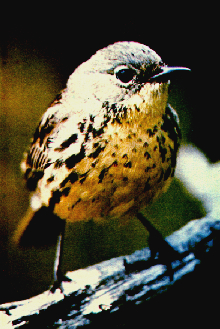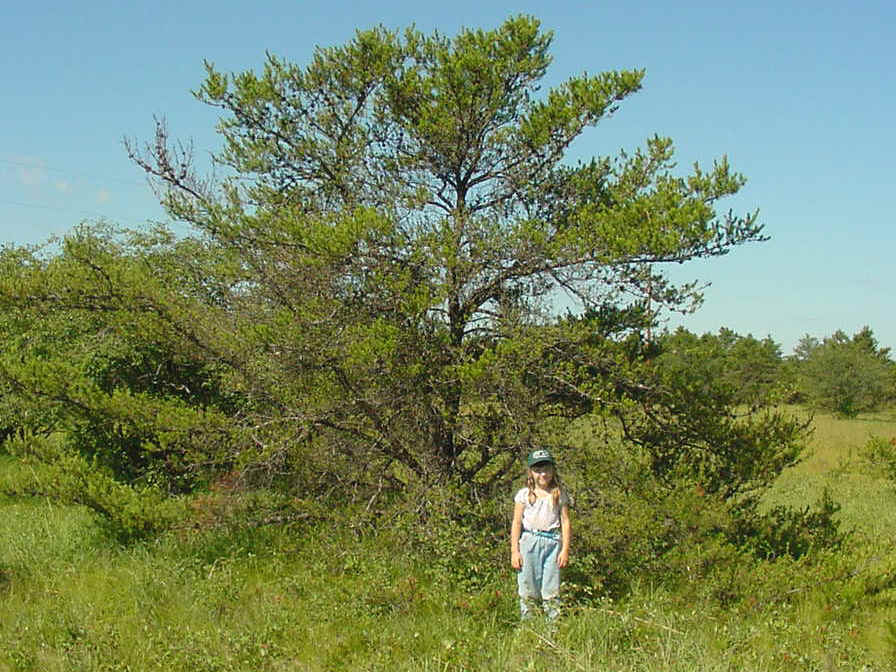KIRTLAND'S WARBLER
The jack pine forests that cover northern Michigan are the summer home of the
state’s rarest bird: Kirtland’s Warbler.

Source: Unknown
The elusive warbler, about the size of a sparrow, is blue-gray and yellow. The Kirtland's
Warbler (Dendroica kirtlandii) is one of the more rare members of the wood
warbler family. Even though it is a bird of unusual interest from many facets, this
yellow-breasted songster's fame is largely due to its rarity. The Kirtland's Warbler has
drawn more official interest and created more controversy than any other songbird in
history.
It was first discovered by Dr. Jared Kirtland, an Ohio physician and
naturalist, on his farm near Cleveland on May 13, 1851. The birds were on their way to
northern Michigan from their winter home in the Bahama Islands at the time.
After identifying the bird as a distinct species and member of the wood
warbler family (Parulidae), the Smithsonian Institute in Washington DC named the birds in
honor of their discoverer, Dr. Kirtland. The wintering grounds of the Kirtland’s
warbler were not found until January 9, 1879, on Andros Island in the Bahamas. During the
summer of 1903, Norman Wood located the first summer nest of the Kirtland’s
warbler in Oscoda County. Every nest that has been found since has been within 80 km
of this spot!

Source: Photograph by Randy Schaetzl, Professor of Geography - Michigan State University
NOTE: This sign reads:
This open area was recently regenerated to provide
future suitable nesting conditions for the Kirtland’s Warbler. This endangered
warbler is a songbird that nests only in this area of Michigan and migrates to its
wintering grounds in the Bahamas. It nests only in young jack pine forests on sandy soils.
Adequate nesting areas consist of approximately 320 acres or larger. The Kirtland’s
Warbler management areas are usually burned to reduce the residues left from logging. The
areas are then densely planted with jack pine seedlings. About 1250 seedlings per acre are
planted to create desirable nesting conditions.
Kirtland’s Warblers will begin nesting in areas such as this one
when the trees reach about 5 feet high (about seven years old). The warbler will nest on
the ground along the edges of small openings. They will continue to use this area until
the needles on the lower branches of the trees start dropping off. This usually occurs
when the trees reach a height of 16 to 20 feet(about 20 years old).
This area will be harvested again after the trees reach about 50 years
old and the warblers have ceased nesting here. Repeating the cycle will result in a
continuous supply of nesting habitat for the warbler. These areas also provide important
habitat of other species such as Upland Sandpipers, Bluebirds, Kestrels, Snowshoe Hares,
and Whitetail Deer.
Kirtland’s Warbler habitat management is a combined effort of the
Michigan Department of Natural Resources, the U.S.D.A. Forest Service, the U.S. Fish and
Wildlife Service, and the Michigan Audubon Society.
The warbler’s peculiar nesting habits have contributed
considerably to restricting the population growth of this tiny bird. The warbler will only
nest in young jack pine stands that are over 80 acres in size. Nesting areas of this type
will usually have clumps of jack pines with low branches, often touching the ground, and
sections of small, grassy clearings. The low branches, like the jack pine below, are
optimal for the warbler nests.

Source: Photograph by Randy Schaetzl, Professor of Geography - Michigan State University
Warblers build their nests on the ground underneath jack pines that are
5-20 feet high, and they will move elsewhere when the trees grow too large. Ironically,
these young jack pines characteristically grow in the aftermath of devastating forest
fires, so as mankind has become more proficient at controlling forest fires, the habitat
of Kirtland’s Warbler has diminished.
Another strike against the Kirtland warbler comes from an unlikely source – the
brownheaded cowbird. Cowbirds lay their eggs in other birds’ nests, and the eggs are
then nurtured by unsuspecting parents (Cardinals are an often-used target for the
Cowbirds.). Many a cowbird had been raised by Kirtland’s warblers at the expense of
their own young.
Recently, however, the endangered bird seems to be making a bit of a
comeback. Through timber harvesting, tree planting and controlled burning, the
world’s only nesting grounds of the Kirtland’s warbler have been maintained.
According to the Michigan Department of Natural Resources (DNR), the state’s warbler
population in 1998 was the highest ever recorded since the first census was taken in 1951.
The census, which counts the number of singing males in the area, is completed in June
every year. (Males establish territory and sing to attract females.) The songs can be heard over one-quarter mile away, providing a
method to count the birds with minimum amount of disturbance. The females do not sing. The
total minimum breeding population is twice the number of singing males. Eight hundred and
five singing males were counted in 1998, with the most being counted in Crawford (175),
Ogemaw (231) and Oscoda (236) counties.
"The number of Kirtland’s Warblers counted in areas specifically planted for the
warbler nesting habitat has continued to increase over the past several years," said
a DNR Wildlife Biologist.
Additional new habitat will become available each year for the next several years, so
there is reason to be optimistic that the warblers will continue to increase. The
Kirtland’s warbler nesting grounds are off limits to the general public, but guided
tours are available. People interested in taking a tour should contact the DNR, or one of
the contacts below.
TOUR INFORMATION
Mio Kirtland's Warbler and Jack Pine Wildlife Viewing Tours:
US Forest Service, Mio Ranger District, 401 Court Street, Mio, MI 48647
Phone: (517)826-3252, Contact Phil Huber or Doug Munson
EMail: fswa/s=p.huber/ou=r09f04d05a@mhs.attmail.com
Grayling Kirtland's Warbler Tour:
US Fish and Wildlife Service, East Lansing Field Office, 2651 Coolidge Road, East Lansing,
MI 48823
Phone: (517)351-2555
Email: r3elfo@mail.fws.gov
FESTIVAL INFORMATION
Kirtland Community College, ATTN: Sandy Figley, 10775 North St. Helen Road, Roscommon, MI
48653
Phone: (517)275-5121, ext. 347
Email: figleys@k2.kirtland.cc.mi.us
On occasion, legislation is introduced in the Michigan Legislature to change the state bird from the Robin to the Kirtland's Warbler. For more information, see the Michigan Legislature's website at: www.legislature.michigan.gov
This material has been compiled for educational use only, and
may not be reproduced without permission. One copy may be printed for personal
use. Please contact Randall Schaetzl (soils@msu.edu)
for more information or permissions.